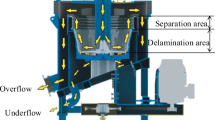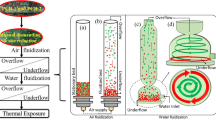Abstract
The crushing performance of printed circuit board (PCB) was studied on several crushers. The results show that PCB is a material which is difficult to crush. The crushing performance of PCB with disk crusher, especially vibration grinding, which has cut or impact action, excels that of jaw crusher or roller crusher. The PCB scrap is worthwhile to recycle using variety of modern characterization methods. When compared with natural resources, this material stream remains a rich precious metal and nonferrous metals. In PCB scrap, metals account for 47% of the total material composition, in which there exists 19.66% copper, 11.47% iron, 3.93% lead, 300 g/t gold and 5–10 kg/t silver, etc. In addition, the PCB scrap contains 27% of plastics and 26% of refractory oxides.
Similar content being viewed by others
References
Scheidt L G, Abdoolcader N, Stadlbauer H, et al. E-lectronics recycling-another dimension[A]. Proceeding of the 1995 IEEE international Symposium on Electronics and Environment[C]. NJ: IEEE, 1995: 290–294.
de Fazio T L, Delchambre A, de Lit P. Disassembly for recycling of office electronic equipment[J]. European Journal of Mechanical and Environmental Engineering, 1997, 42(1): 25–31.
Bertram M, Graedel T E, Rechberger H, et al. The contemporary European copper cycle: Waste management subsystem[J]. Ecological Economics, 2002, 42(1–2): 43–57.
Macauley M, Palmer K, Shih J S. Dealing with electronic waste: Modeling the costs and environmental benefits of computer monitor disposal[J]. Journal of Environmental Management, 2003, 68(1): 13–22. (in Chinese)
BAI Qing-zhong, WANG Hui, HAN Jie. The status of technology and research of mechanical recycling of printed circuit board scrap[J]. Techniques and Equipment for Environmental Pollution Control, 2001, 2(1): 84–89. (in Chinese)
Menad N. Cathode ray tube recycling[J]. Resources, Conservation and Recycling, 1999, 26(3–4): 143–154.
Legarth J B. Environmental decision making for recycling options[J]. Resources, Conservation and Recycling, 1997, 19(2): 109–135.
ZHANG Shun-li, Forssberg E. Electronic scrap characterization for materials recycling [J]. Journal of Waste Management & Resource Recovery, 1997, 3(4): 157–167.
ZHANG Shun-li, Forssberg E. Mechanical recycling of electronics scrap-the current status and prospects [J]. Waste Management & Research, 1998, 16(2): 119–128.
Lee C H, Chang S L, Wang K M, et al. Management of scrap computer recycling in Taiwan[J]. Journal of Hazardous Materials, 2000, 73(3): 209–220.
CUI Ji-rang, Forssberg E. Mechanical recycling of waste electric and electronic equipment: a review[J]. Journal of Hazardous Materials, 2003, 99(3): 243–263.
Brandl H, Bosshard R, Wegmann M. Computermunching microbes: Metal leaching from electronic scrap by bacteria and fungi[J]. Hydrometallurgy, 2001, 59(2–3): 319–326.
WANG Hui, GU Guo-hua. Current status and prospects of recycling of electronic scrap[J]. Environmental Pollution & control, 2003, 25(4): 218–221. (in Chinese)
Menad N, Björkman B, Allain E G. Combustion of plastics contained in electric and electronic scrap[J]. Resources, Conservation and Recycling, 1998, 24(1): 65–85.
Blazsó M, Czégény Z, Csoma C. Pyrolysis and debromination of flame retarded polymers of electronic scrap studied by analytical pyrolysis [J]. Journal of Analytical and Applied Pyrolysis, 2002, 64(2): 249–261.
Author information
Authors and Affiliations
Corresponding author
Additional information
Foundation item: Project (200145) supported by Foundation for the Author of National Excellent Doctoral Dissertation of China; project (02JJYB007) supported by Research Program for the Outstanding Middleaged-Youthful Expert of Hunan Province
Rights and permissions
About this article
Cite this article
Wang, H., Gu, Gh. & Qi, Yf. Crushing performance and resource characteristic of printed circuit board scrap. J Cent. South Univ. Technol. 12, 552–555 (2005). https://doi.org/10.1007/s11771-005-0121-y
Received:
Accepted:
Published:
Issue Date:
DOI: https://doi.org/10.1007/s11771-005-0121-y




